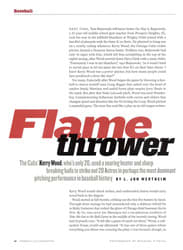
This Breakup Is the Talk of the Town When the river thaws in Nenana, Alaska, a pile of money changes hands
If it weren't for the contest, the town of Nenana, Alaska, might
not exist. Even the mayor agrees. "Without the Ice Classic,"
says Robert Knight, "we'd be devastated financially--and
spiritually." As it is, Nenana barely makes the map. It has one
paved street, two bars and 500 residents, most of whom are
members of either the Athabascan or the Inupiaq tribe.
The town sits beside the Tanana River, 55 miles south of
Fairbanks, in central Alaska. The Tanana is where all the Ice
Classic action--if it can be called that--takes place.
The Ice Classic gets going on Feb. 1, about four months after
the Tanana freezes over. A 26-foot-high wooden structure known
as the Tripod (never mind that it has four legs) is placed in a
trench that has been cut in the ice in the middle of the river.
On shore, across from the Tripod, is a 10-by-10-foot shack.
Inside is a clock. Through an extraordinary rigging system
involving ropes, counterweights, pulleys, a siren and a large
cleaver, the Tripod and the clock are connected.
Before the Tripod goes up, dozens of red five-gallon containers
are shipped to businesses throughout Alaska. These are for
collecting Ice Classic tickets, on which the purchaser must
guess the date, hour and minute that the ice will melt on the
Tanana, sending the Tripod downstream and stopping the clock.
In Alaska the moment of a river's breakup is a significant
event; it is the first sign that spring has arrived. The Classic
has been celebrating this moment since 1917, when 800 guesses
were made for a dollar each. Now, nearly 300,000 tickets are
sold annually, at two dollars apiece, and the jackpot, often
split several ways, is about a third of a million dollars. The
Tripod--a new one must be built each year--is guarded 24 hours a
day by local residents.
Breakup takes place in late April or early May, but several
weeks beforehand, when the ice starts to thin and the April 5
betting deadline approaches, the action around Nenana
intensifies. Newspaper reporters from Anchorage and Fairbanks
arrive (TRIPOD DEFINITELY ON THIN ICE; TRIPOD STILL UP AS ICE
BUCKLES), and Alaskan television stations include ice-thickness
updates as part of their weather coverage. This year the ice
broke at 4:54 p.m. on April 20, and seven winners shared the
bonanza, each getting $42,857.15.
The only multiple winner has been Fairbanks resident Tom Waters,
who drives to Nenana about 20 times every winter to examine the
ice. He compares the current season's weather with historical
trends. He studies railroad schedules. (When a freight train
passes on the nearby tracks, Waters believes, the vibrations
influence the time of breakup.) Then he fills out about 2,000
tickets, the cost paid for by sponsors who receive a share of
his winnings. Waters, 40, won in 1979 and 1983 and has never
missed by more than eight minutes.
Once the betting deadline is past and the canisters are shipped
to Nenana, the pace picks up inside the civic center, a building
that was partly financed by Ice Classic proceeds. The Classic is
a nonprofit corporation. Most of the net income is invested in
the community: The Ice Classic purchases schoolbooks and makes
donations to charities; it pays hospital bills, provides college
scholarships and funds civic events. And for one month every
year it supplies income for nearly one fourth of the area's
population.
Workers come to the civic center to sort tickets and earn
between $5.65 and $6.30 an hour; students work at night,
retirees all day. "Many people come out of the bush to count,"
says Cherrie Forness, the Ice Classic's manager. "This is the
only time they're seen in town all year and the only income they
make. They're subsistence hunters and trappers. They come here
to work, but also to chat, to catch up with one another."
The tabulation is done manually. Forness realizes that by
printing a bar code on each ticket and purchasing a computer
system, she could have all the tickets tallied by a handful of
workers over one weekend. This is not the way the people of
Nenana want it. "Winters here are long and lonely," explains
Forness. "This is an essential escape."
When the ice finally cracks and the Tripod lurches, the siren is
triggered. Everyone hurries to the river to witness the final
moments of the contest. "If you're in school, you play hooky; if
you're sick, you get well; if you're working, you quit what
you're doing," says Forness. "Not a lot goes on here--basically,
this is it. Once the ice goes out, it's pretty boring around
here again."
Michael Finkel, of Bozeman, Mont., is a frequent contributor to
SI.
COLOR PHOTO: ANNE SHERWOOD [Two men maintaining mechanism connected to large tripod on frozen river]
"Many people come out of the bush to count," says Forness. "This
is the only income they make all year."

